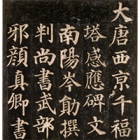Asian Gallery (Toyokan) Room 8
December 1, 2015 (Tue) - January 31, 2016 (Sun)
Chinese calligraphy reached a peak in the Tang dynasty (618-907), and also in the Eastern Jin dynasty (317-420), when Wang Xizhi was active. Calligraphy of the former dynasty, as though reflecting the glory of thriving Tang culture, inherited the style of the Eastern Jin while seeking new forms of beauty. The “standard script” created during the Tang was so near to perfection that no new scripts were created thereafter.
Because Emperor Taizong revered the elegant calligraphy of Wang Xizhi, the former's style spread throughout the imperial court and among the public. The four great calligraphers of this dynasty – Ouyang Xun, Yu Shinan, Chu Suiliang, and Yan Zhenqing – modeled their styles after Wang Xizhi while adding a kind of refinement characteristic of the Tang. Even today, numerous individuals practice the beautiful standard scripts created by these calligraphers.
2015 marks the 1230th anniversary of Yan Zhenqing’s death. Building on tradition, he created a unique style of calligraphy, both powerful and approachable, in addition to brushing numerous masterpieces in less formal “running” and “cursive” scripts. Moreover, in the second half of the Tang dynasty there were also many styles that deviated from tradition and countless masterpieces of an unusual nature.
This 13th collaborative exhibition between the Tokyo National Museum and the Taito City Calligraphy Museum introduces beautiful works of the Tang, during which calligraphy was at a zenith. These include, first and foremost, works by Yan Zhenqing, in addition to ink rubbings by famous Tang calligraphers, copies of Buddhist sutras created by the best transcribers of the imperial court and later excavated from the Mogao Grottoes, as well as privately-created transcriptions.

